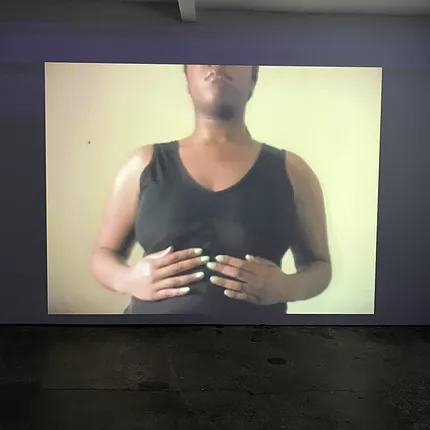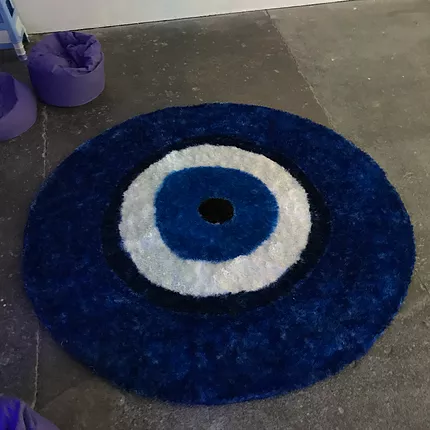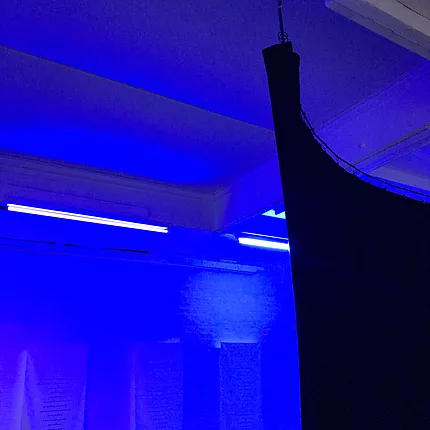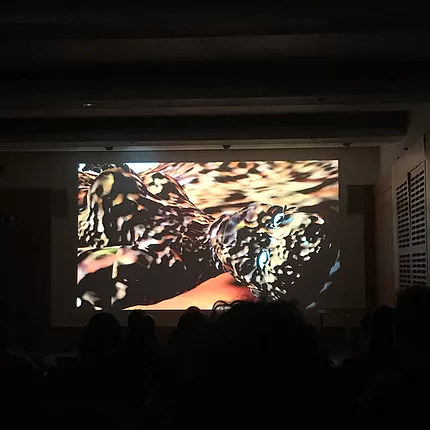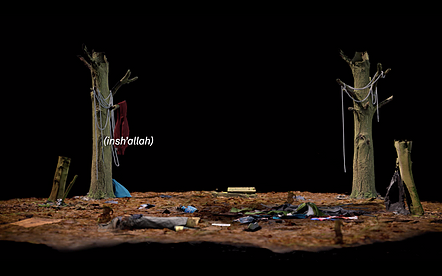3 for 1: Findlater, Zaman & Perretta @ Whitechapel/ Jarman
ZM
Emoji summary: 🔀🤠🌧
This is my last review of the decade! In the spirit of seasonal goodwill & as a parting gift, I am being super duper generous & giving u a 3 for 1 deal. This week I’ve written about Deborah Findlater’s <Sacred Space> @ Cubitt, Rehana Zaman’s <Tell me the story Of all these things> & Imran Perretta’s <15 days> (the last 2 were @ Whitechapel for the Jarman Awards screening last sunday). Ok that’s all.
Deborah’s show, <Sacred Space> at Cubitt makes complete sense if you’ve ever met or spoken to her. Scorpio Queen, it fits; this show is scorpio sun, but resolved. I have started therapy; once every 2 weeks, on a Friday, god bless the nhs. I am 3 sessions in & this friday, my therapist n I were speaking about productivity & the instability, the dissatisfaction or maybe even void of satisfaction, that it fosters as an inherent by product of itself. She said, ‘It is capitalism. What if you were just happy, apart from your productivity or the perception of it?’ I had to slump back in my chair bc I was being Read™️. As I walked to the bus stop after our session, I thought back to when I visited Cubitt the week before. Deborah’s show was like a premonition of that conversation. What if I was just happy, looked after myself because I deserve to be looked after by myself, sat in my body and it was enough. ‘Complete in and of herself, complete in and of herself, complete in and of herself’, I think this is how the film showing in the gallery either begins or ends. Echoing words spoken aloud as a notification rather than as an utterance that makes anything Real or True. The film goes on; split between 3 screens. On one, Deborah paints her nails / on another: does her hair / on the middle screen: restorative touch. The middle screen felt the most solid to me as I watched, broken snotty aching body draped across 3 of the beanbags in the space. These touches, to the chest, neck, stomach; hand laid flat and intentional. They are the acknowledgement of body and presence and validity - my notes from last friday literally say, ‘luxurious but also like a necessary restoration in this rapid movement of aggressive late stage capitalism. Frantic // indulgence’, the conversation I had with my therapist // the same. I have also started listening to Esther Perel’s ‘Where should we begin’ - a podcast of one-off couple’s therapy sessions. In one episode, while talking to a heterosexual couple about their sexlessness, she addresses the woman’s hesitance to touch, even in the most soothing sense. Esther says ‘touch can be masturbatory, but not as you know it now’, meaning that even the caress of your own knee over your trousers, as you sit waiting for the bus; that this can be masturbatory. That any touch that is self-soothing is a degree of masturbatory. Touch and lingering touch, intentional touch of the self is a part of self-maintenance for the outside (the exterior).
As my own body fails, falls apart over & over, as I run it at full speed till the point of collapse, wait for it to recover and then run it at full again; I realise that this show is a pleasant space to sit in, I am enjoying being here and I’ve let the film loop at least 3 times. Where this interiority (in subject matter, in setting) could be singular and played out - trite or shallow in its criticality - it is actually an inversion of white girl art, what white girl art thinks it does, but is inherently incapable of ever attaining. From the film, to the texts on the back wall (printed as banners, like pledges or declarations - intentional and an announcement of accountability); Deborah’s work balances being insular (personally political), and expansive (the kind of politicism that announces itself, collaborative and gently, generously interpolative). Her practice presents itself like an open pore in a sauna; there’s a circular rug that the beanbags I’ve laid down across are circled around, made by textile artist Charlene Sandy, in the shape of an evil eye; the public program that runs alongside the show presents a screening of Zeinabu Irene Davis’ film <Cycles> and a reading by Saint Lov’ie from the zine <Yam and Other Hard Food> as equal in weight & parallel to the work already there; the details for the film even reference the specific audio Deborah’s pulled from (Hortense Spillers, <To the Bone: Some Speculation on Touch>) rather than just appropriate it outright. There is something in this: acknowledging yourself as a singular, and yourself as a plural in an interconnected system, that feels like an action that whiteness can never actually fully achieve. Where whiteness is consistently articulated as a singular, individual state; Deborah is one of many incredible thinkers and makers that have presented blackness as something capable of both singularity and plurality. There isn’t a full-stop after the assertion of the body; Deborah goes on to draw in other bodies & other subjects. It allows itself its own definition apart as well as a definition in context and conversation with other bodies. ‘the answer lay in care, in choosing myself over & over & over again.’ Deborah’s voice echoes on the film as she speaks these words aloud too. Her show predicted the liminal space I now find myself in; I must either shift my weight or continue. I want to be gently, generously interpolative too.
I have seen Rehana Zaman’s <Tell me the story Of all these things> before, in 2016 at Tenderpixel. My review then was brief, and I’m amused that this might be as brief, but I’m happy to approach it a 2nd time. The film flicks between 3 scenes: a CGI figure against a grainy landscape, screen captures from the government’s prevent website, and clips of Rehana’s sister cooking and speaking candidly and intimately about her life and. Well. Of all these things. I wrote in 2016: ‘Farah, a woman who could be any of my aunts. Farah is cooking, speaking about identity / sexuality / her radical self-actualisation / self-emancipation is something she brushes past casually like it was a phase in her life / NBD / she is my youngest aunt who wears stan smiths and listens to Nas but makes incredible biriyani and Believes / she is where east meets west / somewhere between these two things where women are free but still unashamedly b r o w n / she is radical in a casual way / her politics are personal and her life is an example of what radical softness and self-care means in practice / the stakes are high for her but she doesn’t bother caring / she is insistent on living life on her own terms / when I was young, my grandmother told me not to bow to any one but Allah. No Kings, no crowds, no man, not ever. It was only recently that I thought perhaps she didn’t mean bow literally, but maybe figuratively.’ I’m amazed at my own consistency, that that’s still a paragraph I’ll stand by when speaking about this work.
This work, what I wrote at the time was a bit too loose for how I feel about it now. In Farah, it details a complex past, a present that is in the happy process of being brought closer to resolution, and a future that is free from the constraints of expectation. In the CGI figure, it details the overlap, the nexus point of desire and suspicion. In the Prevent clips, the image of perceiving suspicion only. Amongst these 3 points, Rehana scatters clips of her arranging vegetables in a studio, presenting fabric, curling her toes, gesturing with hands. It’s tbh a portrait of a modern British, Muslim, Asian woman. A loving universal scoop into the arms of being rendered as a representation. At no point does it flatten its subject matter, or make it universal. There’s almost the unspoken acknowledgement that this is a singular account; but it’s a singular account in the space of a wider context, where perceptions like suspicion and desire are so heavily weighted against our whole. The unspoken also acknowledges that this ~could~ be a plural, universal account. The lumpy CGI woman’s body matches the grainy background texture. I can’t really decide if I want to call that transparency or opacity, for the sake of any argument I could or maybe should make about her presence here. As the film starts, her lumbering steps outpace ours and she approaches, opening her mouth, and she swallows us whole. The back of her throat matches the texture of her exterior (body & landscape both). She melts into a puddle in the 3rd part, till she’s flat against the ground. She drinks soda from a can only to throw it straight back up and stare at the lumpy, almost solid, sick in front of her. I have never really Got™️ what Ed Atkins was trying to do with his horrible avatars; I have never understood the appeal, the idea of them as abject. In my mind, abjection as a state is not really ever fully complete without a degree of alterity; of otherness and abjection as twin states that are not entirely separable. This 3D woman Rehana has summoned, she is an idol of the sticky relationship between race, womanhood (whatever that’s supposed to mean), sexuality and freedom. She sits against this Wild Wild West backdrop & is bound to these small gestures. Her conversation with Farah is the same description, summons the same stickiness. The Prevent footage is a persistent reminder of how we see radicalism and extremity as a moralised ~bad thing~. Prevent is a targeted strategy that deploys citizens as agents in service of the state to bring other citizens, on the outskirts of extremity back to normality, back to the centre, or neutrality. I think ~we~ (we live in a society…) are bad at conceptualising political positions, all too willing to see them as linear, or spatial even; as centre & extremity/outlier. Maybe rather than that, they should be weighed, valued and positioned according to affect: is this person seeking collective liberation, or partial obliteration of another? This film is a Sagittarius moon, cowboy energy, there’s a quietly articulated (or maybe I’ve projected this?) pursuit of freedom, liberation, the ability to just Do without hinderance (agency), and the supremacy of Self, but gently. Farah tastes the sauce she’s making off her finger, swipes it from the back of a spoon. ‘Mmm bellissimo’, coughs, closes the pan out of shot. She looks at the camera & says ‘coriander time’ deadpan. I love her.
Imran Perretta’s <15 days> made me cry. Imran keeps making films that make me cry, it’s becoming a fucking problem. I’m not even like one of those ppl that cries easily or all the time, I’m baffled by this fully. <15 days> opens with a soft crunchy namaz, one rakat whispered, hushed, solitary. The images on screen are a crumpled mesh of real (?) forest floor - leaves & root - with a digitally rendered tree, branches, laid on top. The camera swivels around and across, empty takeaway boxes, bag for life, subhana rabbiyal azeem, sirens and it cuts to black. I think Imran is very good at building a feeling, a tension or an affect that hits you square. Sometimes, watching his films is like dodging punches. The film cuts back to image: cgi (?) A tent, wonky & ragged, between 2 trees and a stump. According to my lil press release, ‘After the refugee camp near Calais that became known as the Jungle was razed… ’ Imran made <15 days> after spending time in Northern France, ‘with former inhabitants of the Jungle, now living rough in the surrounding woods and fields’. Across this cgi tent, a stage set up for the unfolding of a narrative, we hear a voice in a language I don’t recognise, and subtitles. ‘The only nation I’ve ever know is my mother’ ‘to understand me / you’d have to swallow the world / … mostly first / partly third’, the second line is partially a quote from Salman Rushdie’s Midnight’s children. ‘Partly third’, the line lingers on screen even after the voice has finished saying it. Heavy text, ‘know that I am not the one / they warned you about; / the uncanny stranger / the dark threat; / one of the brown multitude / an ‘almost-but-not-quite’ person’. The text directly addresses the viewer, that I think is assumed to be a white middle class one that populates the constituency of the arts. How do <You> perceive this person’s body, the subjectivities you view their body through? The tent coughs. The side wall of the tent actually trembles like a ribcage, the cough came from the tent. ‘and when he asks my name / I tell him / 15 days; / because that is how long it has been / since the last time you came to take my things / away from me’. A forest floor again, a cgi barricade creaking under its own weight, synthetic feathers (green, blue, red, purple) in the mud. Spitting sound, the tent door is slashed. A gash appears. If the tent here is a proxy or a symbol for the body of 15 days, the person, we’re watching direct & explicit violence being enacted upon that same body. I clench, part of me wants to shout <Jordan Wolfson> because, why, why is this violence being replicated in front of me? What does that do, what does it serve? Replication of violence is the same, unchanged copy, anew. Another, larger, angrier part of me knows that for some of us (myself included, Imran too for sure) we aren’t extended the generosity of being allowed to look away. We see ourselves in these bodies, in these subjectivities, that are beaten, bruised, extracted, rejected, alienated & murdered (directly or by state silence). I am silent and still every time I hear of another drowned in the Mediterranean, or another dead in crossing. This violence is not scripted, like Wolfson’s, it is purposeful & true. It painfully exists.
‘know that / if you flick your lighter once more / I feel like I will go up in flames / I’d like you to know that you are mistaken’ the side wall of the tent is slashed again ‘because I am not capable of violence / only the soft labour of living’ ‘and I’d like you to know that I ache / not from the bruises / but from knowing that you’d rather / I die / quickly / quietly / somewhere else / like the others’. This is not the replication of violence in a direct copy either; the violence is illustrative, a little cold. By transplanting it onto the tent as a proxy body, maybe we ~the viewer~ allow it a distance? Maybe it is more acceptable to this white bourgeois art constituent when it’s tied up in the explanation of a noun: refugee, migrant, asylum seeker. When we see it enacted upon something else that’s apart from those descriptors, maybe it is more visible as an unacceptable and direct violence - and it’s illustrative like that. ‘because how can she know / the trauma of it all’ short clips of faceless white aid workers in neon orange vests handing out boxes and packages flash up behind the tent 'when she can pass / for human in plain sight / while I cannot / because she is offended / but ultimately unaffected / while I am not’. Maybe further, the tent as proxy is a layer of opacity between the violence of being seen, and a fallible body that has endured enough, and must now endure another violence: of being explained, attempted to be understood. ‘and when it’s time to collect my things / once more / there’s this sense / that none of what is happening belongs to me / like I’ve seen this happen in other people’s lives / and now it’s happening in mine / pure affect / no affect / it hurts’. I didn’t notice the tent collapsing. I only noticed when it was flat against the ground; in tatters. I watched the film back at home; private Vimeo link, critic life. I flick back to make sure I catch it, if just for my own curiosity. It sinks slowly, like a body sighing. Not like a tent, but like silk, or skin, or plastic underwater. It turns to a liquid puddle in a slow collapse. ‘a proxy / stuck / performing the slow labour / of waiting’ the film slows, ends on one bracketed word: ‘(insh’allah)’. This, as an ending: Inshallah, as articulation of a fluctuating futurity, a speculative statement. I spoke to my therapist a few weeks back about how I was using the word often, as a way to to answer the intrusive, catastrophic questions posed by anxious hangovers. As a mindful statement: letting go of the future & the unknown, releasing your own control and placing it in the hands of a higher authority (but also, of acknowledging the inevitability of that same future). In <inshallah> as a statement of the speculative, or of futurity, islam interfaces with the metaphysical, rather than fatalism, apathy or defeat. It is an end point, answer in itself, after which there is no utterance in response. It is unstable, fixed & finite.
Deborah Findlater's show <Sacred Spaces> is on @ Cubitt till 15th December. Go see it. The Jarman Award winner will be announced tomorrow (25th Nov) @ the Barbican. Imran Perretta also has a show on @ Spike Island, <the destructors> which i wrote about here

